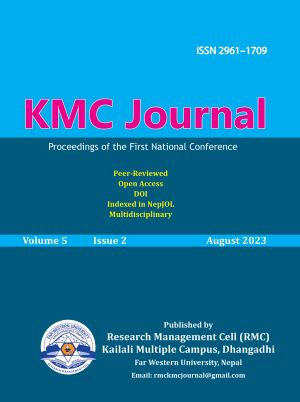Revenue Collection and Spending Effectiveness of Nepal Government
DOI:
https://doi.org/10.3126/kmcj.v5i2.58239Keywords:
Government revenue, government spending, government of Nepal, spending effectivenessAbstract
This study examined and analyzed the revenue collection and effectiveness of spending for the period of 15 years (2005–2020) of the government of Nepal. The study employed the causal-comparative research design. For the comparison of results, it has demarcated findings before and after 2015, because the government of Nepal adopted a federal system instead of a unitary system in 2015. Where the sources of revenues are independent variables, government spending are mediating variables, and measures of effectiveness are dependent variables. Population growth moderates the relationship between revenue collection and spending. Similarly, corruption and inflation rate moderate the relationship between government spending and measure of effectiveness. The empirical data were taken from the official website of the Nepal Government and the World Bank. Three effectiveness measuring variables have appeared increasing for the study period. But employment to total population ratio has been found to decrease. Government spending has been positively related to per capita income after 2015, which was negative before that period. Government spending on health has been found positive and significant relationship with life expectancy at birth. Education expenditure has been found positively associated with the literacy rate after 2015, whereas there was a negative association before that period. The outcome of the study will be applicable to identify the areas for fiscal policy improvement to better serve its citizen.
Downloads
Downloads
Published
How to Cite
Issue
Section
License

This work is licensed under a Creative Commons Attribution-NonCommercial 4.0 International License.
This license allows reusers to distribute, remix, adapt, and build upon the material in any medium or format for noncommercial purposes only, and only so long as attribution is given to the creator.




